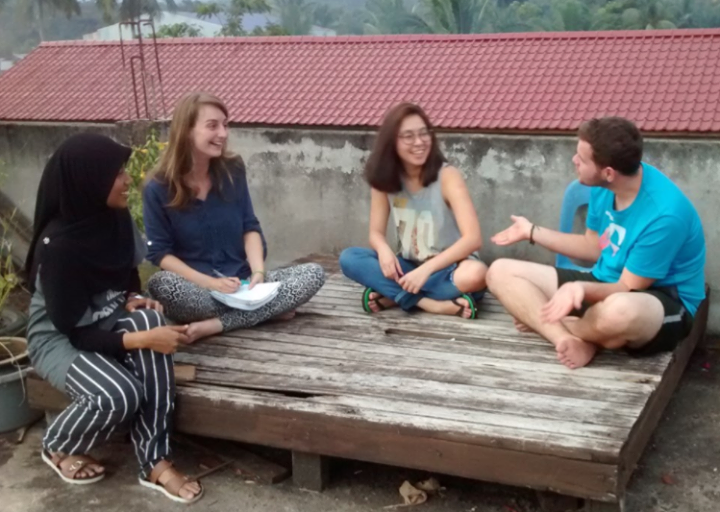How the CMC course is helping me tackle a real organisational challenge

Article courtesy of Eleanor Devenish, our Conservation intern and distance learning student
Greetings from Malaysia!
I'm very excited to be undertaking the second module of the Cambridge Marketing College Certificate in Professional Marketing – Integrated Communications. I'm now working out in Malaysia with Fuze Ecoteer and am currently based at their rainforest conservation project in Merapoh. With its rich culture, beautiful wildlife and amazing food, this is a truly incredible place!
How the CMC course is helping me tackle a real organisational challenge
The list is endless, so I'll share with you just some of the ways. My task at Fuze Ecoteer is to focus our marketing efforts on increasing the number and quality of volunteers and interns joining three of our fantastic projects: rainforest conservation and community work at Merpoh, marine conservation research at Perhentian Island and wildlife rehabilitation at Jogja Wildlife Rescue Centre, Indonesia. The aim is to attract a new target segment – those that are aspiring conservationists looking to kick start their career by building skills and experience.
The first module, 'Marketing', has provided some excellent tools for understanding where your organisation is currently at and where it needs to be in the future. It helps answer crucial questions, from how to set organisational goals and targets to how to measure the success of a project. Once the big picture is understood, it teaches you how to generate marketing strategies and tactics to achieve these objectives – focusing on the 7Ps of marketing: Product, Price, Place, Promotion, Process, People and Physical Evidence. Nothing would be complete without setting targets and measuring progress – and the course provides some very comprehensive tools for this too.
How SOSTAC has helped me create a marketing plan
The tool that I'm now using to generate a marketing plan for Fuze Ecoteer is SOSTAC.
- The 'S' stands for situational analysis – where is the organisation and its projects currently at? What are its internal strengths and weaknesses? How can these be managed, or used to mitigate against threats or make the most of opportunities? What are our competitors doing?
- The 'O' stands for objectives – with our current competencies and resources in mind, where do we want the organisation to be? What are the goals?
- Next is strategy – there are multiple strategy frameworks to choose from – these aim to provide a high-level approach to understanding how the objectives will be met. I've been using the Ansoff Matrix – should I be selling existing products to existing markets, or new markets? Maybe there needs to be new products – what market should these be targeted at? Whilst some of the projects will stay largely the same at Fuze Ecoteer, others will be modified to meet the needs of our new target audience, so this has been an extremely useful piece of guidance from the CMC.
- Next is the tactics used to fulfil the strategy – here we look at the 7Ps of marketing mentioned earlier. One of the most useful things that CMC has taught me is to ensure all the Ps complement each other and are not looked at in isolation. This will be especially important when developing new packages to meet the needs of different groups that we'll be targeting for the first time.
- 'A' stands for action plan. Who needs to do what? What resources are needed? What about budgeting? And what are the timeframes? Setting SMART objectives is critical here – specific, measurable, achievable, realistic and time-bound.
- Finally, 'C' stands for control. This is where the CMC course has really helped me to understand how to set targets and measure success. It ensures that each of the 7Ps is considered and gives examples for how to measure the progress of each. This has been invaluable for working tangible outcomes into my marketing plan, providing a clear understanding of what to work towards. Whilst with some marketing activities there will be a time lag before you get the result you want, CMC has shown me that there are so many ways to measure ongoing progress. For example, if your aim is to motivate agents to better sell your product, it may be a while before a higher conversion rate is achieved, but other measures might include the way that they talk about your brand, the positioning of your products on their website, their responsiveness to your suggestions and feedback. This is great for understanding what works and what needs to be improved – and to ensure things are on track.
How the Integrated Communications module is helping to generate ideas
The Integrated Communications module is all about making the most of both internal and external communication. The first chapter highlights the importance of building cross-functional relationships within your organisation to ultimately benefit the customer. It emphasises that employees are an important source of innovation and should be involved in developing ideas. This has been especially relevant for me and as I've began sharing volunteer feedback to project staff, I've been met with some brilliant ideas from very motivated people. This really has been invaluable for understanding how to target our new segment and understanding how the 7Ps should be used together to create packages that will meet customer needs. After all, the interns at Fuze Ecoteer are exactly the kind of people we want to attract! This section also talks about the various methods of internal communication – this is especially relevant in Fuze Ecoteer's case, where staff are spread out in the different project locations, often with little internet and in the remote (but very beautiful) field.
I'm excited about the next chapter – managing resources to deliver effective marketing solutions. Again, this is extremely relevant for a small organisation, but something that all companies must think about. Knowing how much to spend on communications and looking at budgeting is a skill highly sought after. In the case of sustainable marketing, an added consideration is that, if not done well, it can cause a lot of negative attitude from the public. This is especially relevant where those supporting charities or social enterprises would rather their money went to the cause than a flash advertising campaign!
Every day I'm using the course material to help solve problems and plan effective marketing campaigns. It really does help with the many questions I have about approaching new situations.
Selamat tinggal!



